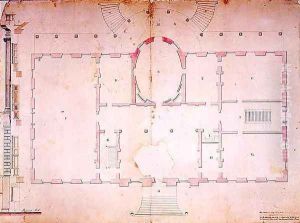James Hoban Paintings
James Hoban was an Irish-born American architect, best known for designing one of the most iconic buildings in the United States: the White House in Washington, D.C. Born in 1758 in Desart, County Kilkenny, Ireland, Hoban was educated at the Dublin Society's Drawing School, where he studied architecture under Thomas Ivory. He emigrated to the United States in the late 1780s, following the American Revolutionary War, and initially settled in Philadelphia. Soon after, he moved to South Carolina, where he began to establish his reputation as an architect.
In 1792, Hoban won the competition to design the presidential mansion, later known as the White House, in the newly established capital city of Washington, D.C. His design was influenced by the Leinster House in Dublin, a building that is now the seat of the Oireachtas, the Irish parliament. Construction of the White House began in 1793, and it was ready for occupancy in 1800. Although the building was burned by British forces in 1814 during the War of 1812, Hoban was commissioned to oversee its reconstruction, restoring it almost to its original design by 1817.
Beyond the White House, James Hoban's architectural legacy includes other significant buildings and contributions. He worked on the design and construction of several other important structures in Washington, D.C., and was involved in the development of the capital's urban plan. Among his works are the Old Executive Office Building, adjacent to the White House, and parts of the U.S. Capitol. His influence extended beyond Washington, with buildings designed by him standing in other parts of the United States, reflecting the neoclassical style that was popular in America at the time.
James Hoban's contribution to American architecture, particularly through his work on the White House, has cemented his legacy as a pivotal figure in the development of the nation's architectural identity. He died on December 8, 1831, in Washington, D.C., but his work continues to be celebrated for its historical significance and enduring beauty.
